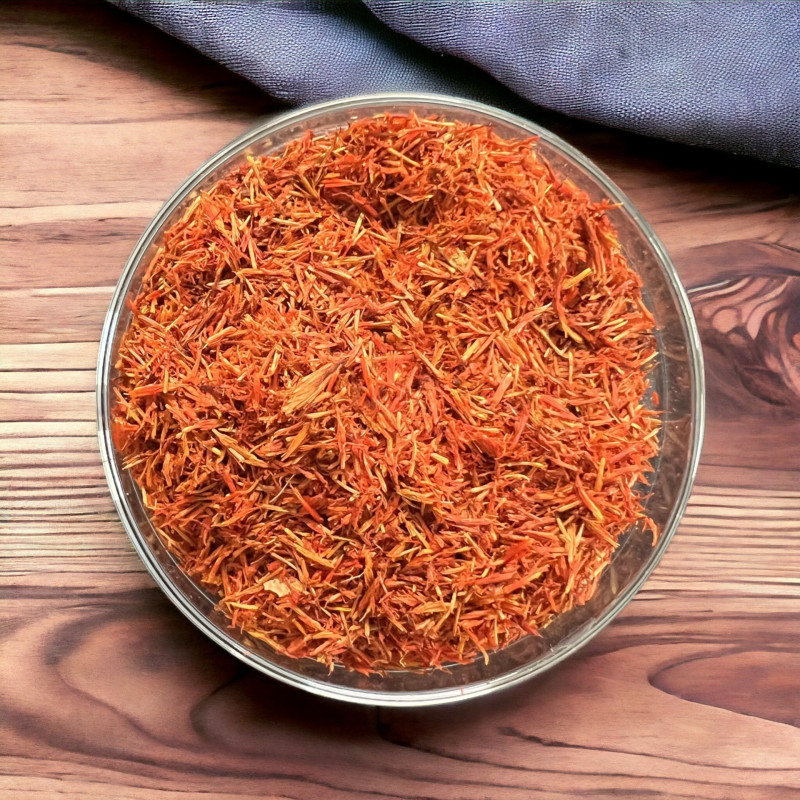
Reference: safranpistil


It is mainly for their striking resemblance to saffron stigmas that safflower petals are used.
They are perfect for decorating and adding color to your dishes, as well as for dyeing fabrics and creating potpourris.
 Delivery
Delivery
Mondial Relay
 Returns
Returns
See conditions
 Payments
Payments
100% secure
- Livré en sachet refermable -
Uses in Cooking:
Safflower is a flower that resembles a thistle, though the color is quite different! It forms a pompom-like bloom with very fine petals.
Here are several ways to use safflower petals:
As a garnish for cooked dishes, particularly in fish dishes flavored with real saffron, to give the illusion of saffron threads! Safflower also works well as a decorative touch in fish or seafood salads.
For coloring dishes, as an affordable alternative to saffron, which is far more expensive. However, keep in mind that safflower does not replicate saffron’s flavor, as its taste is quite neutral! You can color a dish with safflower, but if you want the taste of saffron, you’ll need to add actual saffron to avoid disappointment.
This close resemblance to saffron stigmas has not gone unnoticed! In many North African tourist destinations, safflower is often sold in small, tightly closed sachets (masking the lack of fragrance) labeled as saffron—and at nearly saffron’s price! This trick deceives thousands of tourists each year who are not familiar with the true look and scent of saffron.
In potpourris, safflower petals add a beautiful red hue that is highly resistant to light.
For dyeing natural fabrics like cotton, yielding colors from pink to red, light orange, and yellow, depending on the quantity of safflower used.
From the plant’s seeds, a culinary oil with various health benefits is also produced.
Who am I?
Origin: Iran
Common names: Dyer’s saffron, False saffron, Mexican saffron, Parrot seed
Scientific name: Carthamus tinctorius
The botanical genus Carthamus includes plants mostly from the Mediterranean, belonging to the Asteraceae (or Compositae) family, closely related to thistles. Safflower is an annual, woody plant with dark green, spiny leaves. Its bright yellow-orange flowers bloom from July to September.
This plant grows wild in Iran, China, Japan, Australia, and Central and South America. In France, it was once cultivated in regions like the Midi, Alsace, and Lyon for its dye properties. The flowers contain colorants (yellow carthamine and red carthamon), historically used to dye Chinese silk and clothing such as the robes of Buddhist monks. Today, few safflower crops remain, though wild safflower can occasionally be found on fallow lands and embankments.
The seeds are harvested in October. They resemble large barley grains, white or brownish with gray, brown, or black stripes. These seeds are used to produce culinary or massage oils, sometimes incorporated into hair care products. They also serve in the chemical industry for making varnishes and paints. Finally, they are used as bird feed, especially for parrots, who enjoy their bitter taste, giving the plant its nickname "parrot seed."
A Little History:
The name Carthamus is borrowed from Arabic, rooted in a Semitic term meaning "to dye." This term naturally relates to the flower's dye properties, which are somewhat similar to those of saffron.
This low-growing plant, reaching 60 cm, originates from Egypt, where it has been known since ancient times. The Egyptians used it as a dye, ranging from yellow to red, for the wrappings of mummies, as it was believed to protect against mold.
Data sheet
Reference: safranpistil
Reference: EPI2301003
Reference: souci
Reference: jasmin
Reference: 112390010
Reference: camomilleRom
Reference: rosepetale
Reference: 26545D
Reference: bleuet
Reference: 10M6810601
Reference: mauve
Reference: souci
Reference: rosepetale

It is mainly for their striking resemblance to saffron stigmas that safflower petals are used.
They are perfect for decorating and adding color to your dishes, as well as for dyeing fabrics and creating potpourris.